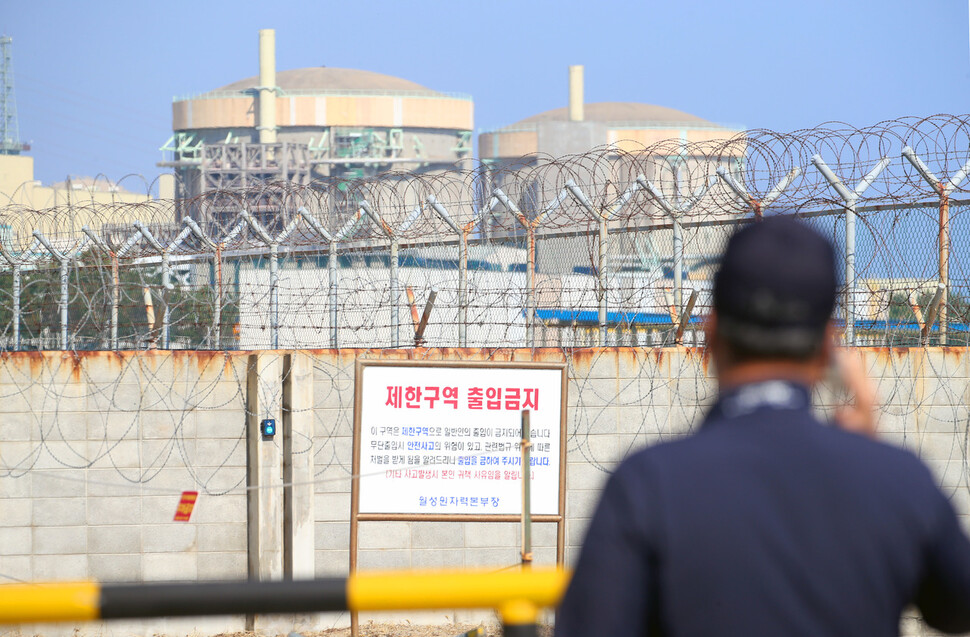KHNP, measured north and southwest of Wolseong Nuclear Power Plant, “no spillage”, whereas the results of the Geological Resources Institute and KEPCO Electric Power Institute
Possibility of groundwater flowing to the east and entering the sea
“When the tritium outflow continues, the environment enters in one year”

Wolseong Nuclear Power Plant in Yangnam-myeon, Gyeongju-si, where the tritium leak underground is controversial. The one to the right is the permanently suspended Wolseong Unit 1. yunhap news
It has been confirmed that there is a research result from a national research institute in the past that if tritium leaks from the Wolseong nuclear power plant to the basement, it can escape from the site of the nuclear power plant as early as one year. A research team composed of researchers from the Korea Institute of Geoscience and Mineral Resources and KEPCO Electric Power Research Institute presented the results of the modeling analysis of this content at the 2010 Fall Conference of the Korean Radioactive Waste Society. The research results of this research team are contrary to the explanation of Korea Hydro & Nuclear Power’s recent controversy about whether tritium leaks out of the groundwater at the Wolseong nuclear power plant site. In a media report pointing out the possibility of an external leak of tritium leaked into the basement of the Wolseong nuclear power plant, KHNP said, “It is not judged that the radioactive groundwater has spread outside the site of the nuclear power plant.” In the explanatory data on media reports, KHNP heard that tritium was not detected or was detected at a low concentration in the groundwater environmental radioactivity survey in the area around the Wolseong nuclear power plant last year. Environmental radiation investigation is a legal investigation that nuclear power generators are required to conduct annually in accordance with the regulations of the Nuclear Safety Act. Last year’s Wolseong nuclear power plant-related survey included samples of soil, water, benthic organisms, and foods collected from 24 areas and 76 locations around the site. In this survey, groundwater samples were collected in two locations near the nuclear power plant and one in Gyeongju and Ulsan, which are comparative areas. According to the results of joint research between the Korea Institute of Geoscience and Mineral Resources and KEPCO Electric Power Research Institute, this groundwater sampling point is a point away from the direction of movement of groundwater in the Wolseong nuclear power plant site. The researchers divided the entire site of the Wolseong nuclear power plant into a grid of 5 to 10 m and then modeled the movement of groundwater by dividing the basement into four layers based on the existing geological survey data. Then, it was found that most of the groundwater from all levels under the Wolseong Nuclear Power Plant site moved toward the east coast.

Environmental radiation sampling point
On the other hand, the groundwater measurement point in Bonggil-ri, Yangbuk-myeon, Gyeongju, where 4.8 Bq/L of tritium was detected in last year’s environmental radiation survey, is about 2.5 km north of the nuclear power plant. The groundwater measurement point in Nasan-ri, Yangnam-myeon, Gyeongju-si, where tritium was not detected, is about 2km southwest of the nuclear power plant. The groundwater survey point was selected without considering the movement direction of groundwater from the site of the nuclear power plant. Among the environmental radioactivity investigation points, the only area to the east of the Wolseong nuclear power plant site is around the drain and water intake of the nuclear power plant. It is said that it is impossible to determine whether radioactive substances are introduced into the environment through groundwater through the existing environmental radiation survey. As a result of modeling the continuous leakage of tritium around the major facilities of Wolseong Units 1 and 2, the researchers predicted that the tritium would reach the shore in one year in the first layer close to the surface. In addition, the second floor was simulated to reach the coast two years ago, and the third floor, which is further down, 10 years later. In two groundwater monitoring wells and two site boundary wells installed by KHNP at Wolseong Nuclear Power Plant, a maximum of 912 to 3770 Bq/L of tritium was detected between January 2013 and May last year. Among them, the monitoring well (SP5) of Unit 3, which recorded 3770Bq/L, is only 90m away from the sea. In particular, the distance between the site boundary well (NE1) of Unit 1, where the maximum of 1230Bq/L was detected, and the sea is only 50m. When these detection results and the groundwater movement modeling results of the Wolseong nuclear power plant site are put together, it is difficult to conclude that there was no leakage of tritium to the outside of the nuclear power plant. Ik-joong Kim, a former professor at Dongguk University School of Medicine, who served as a member of the Nuclear Safety Committee, said, “All the groundwater of the Wolseong nuclear power plant containing radioactive substances flows to the east and enters the sea. “We shouldn’t just say that the KHNP is safe without knowing how much of it is flowing through the groundwater.” Senior reporter Kim Jeong-soo [email protected]
